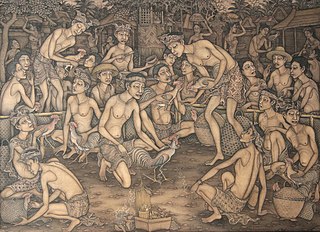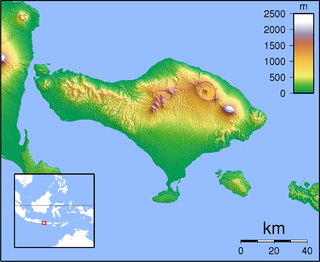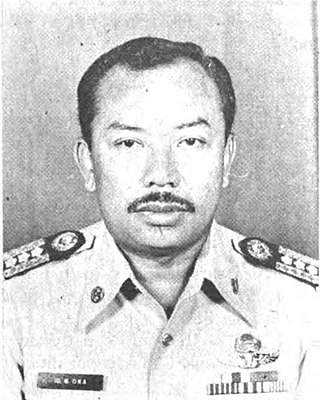A Balinese name is part of a system of identification used by the Balinese people and in the western parts of the neighboring island of Lombok,Indonesia. A Balinese name will have three parts:a title,a birth order name and a personal name. Balinese people do not use a family name.

Balinese art is art of Hindu-Javanese origin that grew from the work of artisans of the Majapahit Kingdom,with their expansion to Bali in the late 14th century. From the sixteenth until the twentieth centuries,the village of Kamasan,Klungkung,was the centre of classical Balinese art. During the first part of the twentieth century,new varieties of Balinese art developed. Since the late twentieth century,Ubud and its neighboring villages established a reputation as the center of Balinese art.

The Klungkung Palace,officially Puri Agung Semarapura,is a historical building complex situated in Semarapura,the capital of the Klungkung Regency (kabupaten) on Bali,Indonesia. The palace (puri) was erected at the end of the 17th century,but largely destroyed during the Dutch colonial conquest in 1908. Today the basic remains of the palace are the court of justice,the Kertha Gosa Pavilion,and the main gate that bears the date Saka 1622. Within the old palace compound is also a floating pavilion,the Bale Kembang. The descendants of the rajas that once ruled Klungkung today live in Puri Agung,a residence to the west of the old palace,which was built after 1929.

The Dutch intervention in Bali in 1908 marked the final phase of Dutch colonial control over the island of Bali in Indonesia. It was the seventh and last military intervention in Bali,following the Dutch intervention in Bali (1906).

The History of Bali covers a period from the Paleolithic to the present,and is characterized by migrations of people and cultures from other parts of Asia. In the 16th century,the history of Bali started to be marked by Western influence with the arrival of Europeans,to become,after a long and difficult colonial period under the Dutch,an example of the preservation of traditional cultures and a key tourist destination.

Sri Kesari Warmadewa was the first king of Bali whose name is recorded in a written inscription. He was the issuing authority for four inscriptions,including the famous 914 CE inscription on the Belanjong pillar in southern Sanur.

Dalem Ketut was a king (Dalem) of Bali who ruled at an uncertain time during the age of the Javanese Majapahit Empire. While first a vassal ruler under the Majapahit kings,he later emerged as the king of a separate island realm. He was also known under the names Sri Smara Kepakisan or Tegal Besung. Dewa Tegal Besung is the earliest deified ruler who is honoured at the Pura Padharman Dalem Gelgel,the most important shrine at the central Balinese temple Pura Besakih.

Dalem Segening was a king of Bali who reigned in the first half of the 17th century,his exact dating being still uncertain. He belonged to a dynasty which originated from Majapahit on Java,and ruled from the palace (puri) of Gelgel.

Dalem Di Made was a king of Bali who may have reigned in the period 1623–1642. He belonged to a dynasty that claimed descent from the Majapahit Empire of Java,and kept residence in Gelgel,close to Bali's south coast.
Dewa Cawu was a prince on the Island of Bali,who possibly reigned as king for a short while in the 1650s. He belonged to a dynasty that claimed descent from the Hindu-Javanese Majapahit Empire,and kept its palace (puri) in Gelgel near Bali's south coast.
Balinese Kshatriya is a Hindu Kshatriya community which exists in the island of Bali in Indonesia. During the second half of the sixth century,Bali had a strong Kshatriya ruling dynasty. The rulers were mostly indigenous Balinese with some Indian blood. These clans mostly belonged to the Nāgavanshi dynasty. However,in due time,these indigenous Kshatriyas became extinct and were replaced by the Javanese Kshatriyas who immigrated to Bali. Most of the Kshatriyas now living in Bali are claimed to be the descendants of the King Dewa Agung,who immigrated to Bali from Java. However,there are also a few other Kshatriya clans who were elevated to the Kshatriya status from the Vaishya varna. All together,Kshatriyas constitute around 4% of the total Balinese Hindu population.

The Dutch intervention in Lombok and Karangasem took place in 1894,and is part of the string of Dutch interventions in and around Bali that led to complete colonization of both Bali and Lombok by the early 20th century.

Pura Kehen is a Balinese Hindu temple located in Cempaga,Bangli Regency,Bali. The temple is set on the foot of a wooded hill,about 2 kilometres (1.2 mi) north of the town center. Established at least in the 13th-century,Pura Kehen was the royal temple of the Bangli Kingdom,now the Regency of Bangli.

Penglipuran Village is one of the traditional villages located in Bangli Regency,Bali Province,Indonesia. Penglipuran village is famous as one of the tourist destinations in Bali because of its society who still preserve their traditional culture in their daily lives. The architecture of buildings and land processing still follows the concept of Tri Hita Karana,the philosophy of Balinese society regarding the balance of relations between God,humans and their environment. Penglipuran Village succeeded in building tourism that benefited all of their communities without losing their culture and traditions. In 1995,Penglipuran Village also received a Kalpataru award from the Indonesian Government for its efforts to protect the Bamboo Forest in their local ecosystem.
The Paruman Agung was the regional parliament of Bali from 1938 until 1950.

I Dewa Gde Oka is an Indonesian military officer and politician who served as the Vice Governor of Bali from 1985 until 1989 and as a member of the People's Representative Council from 1997 until 1999.










